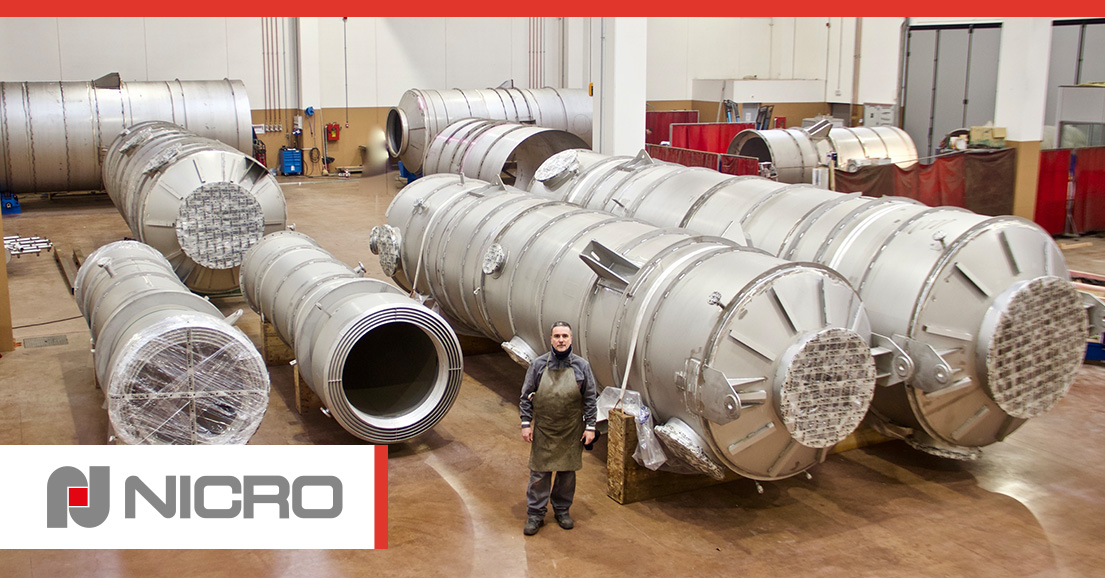Nicro: Experience and avant-garde in marine scrubbers

Avant-garde: this is the keyword that describes Nicro. For almost fifty years Nicro represents the pioneer of innovations in the special machining of metal alloys, realizing complex and very large custom projects.
This includes marine scrubbers for vessels. These innovative systems have become mandatory from 1 January 2020, following the tightening of marine pollution standards. They are equipped with filters to reduce sulphur dioxide, sulphur oxides, hydrocarbons, heavy metals, carbon monoxide, soot and ashes in water and air thats why they bring into play all Nicro’s specialized knowledge from the choice of the best materials, to the latest technologies in plasma welding.
Our highly specialized technicians will be ready to advise you in choosing the most suitable system: for example, if you want to save on high reagents prices or on the cargo space, wet scrubbers could be for you.
Wet scrubbers: functioning
Unlike the dry scrubbers, that use granules treated with caustic lime, wet scrubbers pass the exhaust gases through a liquid that reacts chemically. The most commonly used liquids are fresh water, chemically treated to give it the right degree of alkalinity, or sea water that could be taken or discharged in the open-loop systems.
Wet scrubber systems usually include:
- A scrubber unit, a container that connects the water to the exhaust gas
- A treatment plant to clean up the washing water before discharge into the sea (only in opon-loop mode)
- A plant to treat the residue of the washing
- A control system for the scrubber and for monitoring emissions
The scrubber’s inlet for the exhaust gas is often represented by a Venturi pipe on the side or bottom of the washing tower. It is a tube with a shrinkage, near which the gases crossing speed increases. It is in these high-speed areas that water is sprayed for the treatment, as an alternative to the top-spray from above the neck tube.
The water used in this phase distinguishes wet scrubbers between open and closed loop, affecting the presence of additional components in the purification system between between pumps, tanks and monitoring and control instruments. In fact, the open-loop systems use just seawater, charged from the outside with a dedicated pump. Instead, closed-loop systems use washing water independent of the external one. THerefore, it it may also be fresh water treated to achieve the right degree of alkalinity.
In the last few years, the so-called hybrid scrubbers have also spread, combining the open-loop and closed-loop benefits. Their initial cost is high, but the system works with low cost fuels and it allows you to navigate for longer periods of time and in compliance with all the international regulations, so that costs are quickly amortized.
In fact, open-loop hybrid scrubbers avoid the purchase of caustic soda and and treatment of washing water. They guarantee the same efficiency of closed-loop systems both in costal water and controlled emission areas and it is require a very low maintenance. The transition from one circuit to another takes place acting on the suction and circulation pump that sucks in the sea water and discharges it at the end of the process overboard or in the recirculation tank.
The disadvantages are instead related to the need to create an ad hoc plant that changes, in many cases, the structure of the boats. In fact, storage tanks and storage spaces to contain wastewater until it can be discharged are needed. Provision must also be made for SCR (Selective Catalytic Reduction systems), in order to purify the gases before getting to the scrubber. The installation can therefore be complex, especially for dual-fuel engines, with particularly high installation times and costs.
Whether you are looking for a wet or dry scrubber, Nicro technical consultants are at your disposal to recommend the best scrubber for your needs. Contacting Nicro means applying to a company that can work on complex and customized projects, taking into account the needs in terms of spaces, rental programs, engine power and on-board boiler, availability of fresh water and power on board to operate the system in different conditions.
